What other breeds look like pit bulls?
Over a dozen breeds resemble American pit bull terriers and are regularly confused with them. We discuss most of the common ones above.
What type of bully breed is best?
The best bully breed is the one that works with your lifestyle. Some people enjoy the laid-back nature of English bulldogs, while others love the sportiness of APBTs.
Other Breeds Sometimes Confused with Pit Bulls
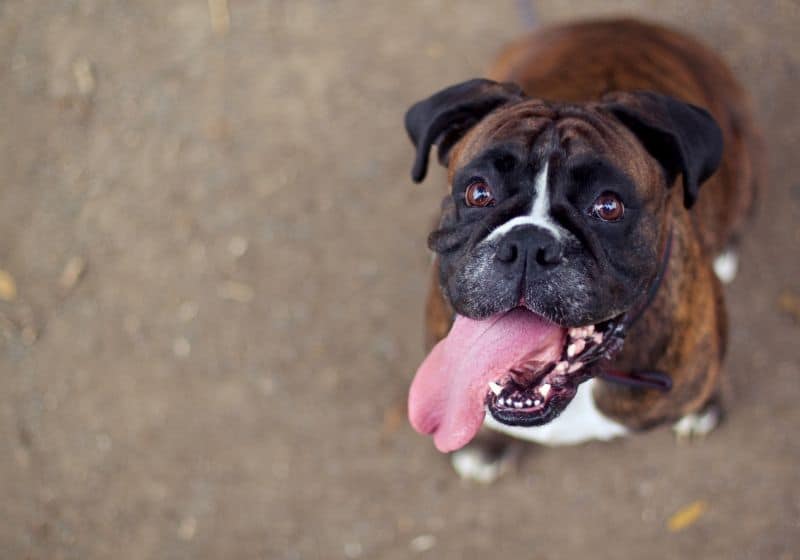
The four breeds discussed previously are all somewhat closely related and share relatively similar histories, which helps explain why they’re often lumped into the same “pit bull” category.
But there are also a few breeds who aren’t particularly closely related to pitties that people often confuse with pit bulls — they’re often lumped together as a group known as “bully breeds.”
But it is important to note that this only occurs because these breeds have blocky heads, which make them vaguely similar-looking to pitties.
We’ll discuss some of the most notable examples below.
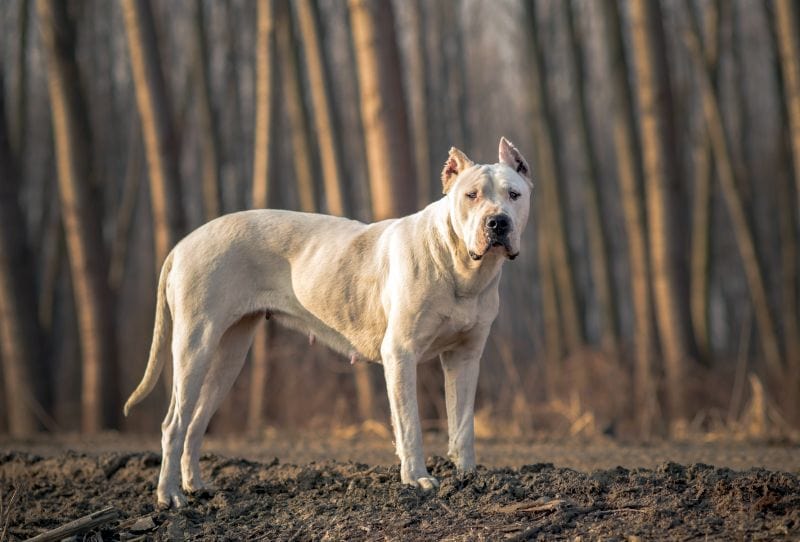
About: A mighty hunting breed from Argentina, the Dogo Argentino is regularly mistaken for being a white pit bull. These mastiffs are much larger, however.
History: Originally developed for blood sports, this breed proved himself to be a formidable hunting companion in the early 20th century. He regularly joined big game hunts for a multitude of wildlife, including pumas and wild boar. Over time, they found themselves working in guardian and companion roles, too.
Description: The Dogo is a large dog weighing between 80 and 100 pounds. He stands between 24 and 27 inches at the withers. While he’s a powerful breed, he should still move with grace and agility. His shoulders are shapely and should be well-muscled but not disproportionately so.
His head is impressive but shouldn’t appear bulky or oversized. It’s wide without wrinkles and appears smooth. His eyes are always dark, and his expression should remain alert with his ears set high. He has a blocky muzzle and a thick neck, which often leads to his confusion with other bully breeds.
Dogos have a short, straight coat that is smooth and glossy. It lays flat and is never long or wavy.
Colors: The Dogo is entirely white, though an occasional black spot is acceptable.
Common Health Issues: Dogos live an average of 10 to 12 years and may experience a few health problems, including:
Breed Registries:
The Dogo is fiercely protective of his family and home. He adapts well to family life and children, though he needs time to warm up to unfamiliar faces. In addition to socializing with people, he needs repeated positive exposures to other dogs and animals to prevent aggression.
Dogos are not a breed for newbies. They’re assertive and will challenge you. Because of this and their size, training must start immediately and be ongoing. He needs to learn boundaries before he’s too large and unmanageable. Keep training positive and consistent.
His short coat doesn’t require much grooming. He only needs a bath when absolutely necessary, though his coloring can leave him vulnerable to sunburn, so take preventative measures when necessary, such as using t-shirts to shield his skin. You may also need to discourage him from lazing in the sun during high UV index days.
Dogos have some of the highest exercise requirements of all bully breeds. He’s a strong dog who has seemingly unlimited energy at times. Daily exercise is a must and is best achieved through jogging, hiking, long walks, and mental stimulation such as puzzles or sports, like obedience and agility. He is not a dog for lazy owners.
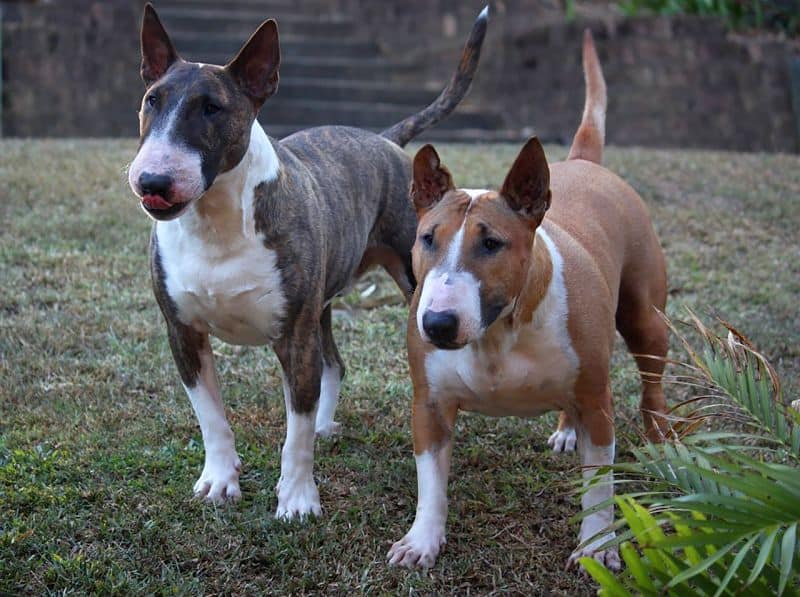
About: The bull terrier is a solid dog made to work. Recognizable by his distinct look, this precocious potato head is occasionally confused with other bully breeds because of his name, expression, and coloring.
History: A relative of the bulldog and Staffordshire bull terrier, the bull terrier is the result of mixing bulldogs with various terriers to create a more ferocious dog for bull baiting and other blood sports. Once the sports were finally outlawed, bull terriers found their place in the home and assumed the role of companion.
Today, these adorable pups with odd-looking faces continue to keep us company, but they also make excellent vermin catchers.
Description: Bull terriers come in two size sets: standard and miniature. The standard bull terrier stands at 20 to 24 inches tall and weighs 45 to 80 pounds. The miniature stands 10 to 14 inches high and weighs 24 to 33 pounds. The bull terrier body is muscled but never bulky or overly rounded like that of a bulldog.
The bull terrier has a unique head that is long and oval, often called “egg-shaped” by breeders. His eyes are dark and sunken in nature. His nose is always black, and his ears sit high and pricked upward.
Bull terriers have a short coat that is shiny and coarse in texture. Unlike other bully breeds, his skin isn’t wrinkled and sits tight against him body-wide.
Colors: Bull terriers are lumped into two groups by the AKC: white and colored. White dogs may have coloring on the head but should be entirely white elsewhere. Colored variants are black, brindle, red, fawn, and tricolor.
Common Health Issues: Bull terriers have a life expectancy of 10 to 14 years and may exhibit some health problems, like:
Additionally, some authorities suspect that bull terriers may be one of the few breeds to exhibit autistic-like behaviors.
Breed Registries:
Bull terriers are friendly pups that have never met a stranger.
He’s a solid choice for a family dog and thrives when he’s with his humans. He doesn’t always extend this same welcoming to other dogs or animals, however, so early socialization is a must.
Expect a lot of laughs with your bull terrier because he’s renowned in the dog world for his goofiness.
While a fun-loving goofball, he’s also a terrier, and he’s one of the trickier bully breeds to train. He has a mind of his own and will put it to use as he sees fit, which might mean cutting your training time short.
Consistent, positive training should be started early, but expect your bull terrier to have his moments. It’s just part of his personality. He is not a good choice for a first-time dog owner.
The bull terrier’s short coat sheds seasonally. He doesn’t require a ton of grooming, with the occasional brushing and bath maintaining his good looks.
The bull terrier is an energetic pup that needs daily mental and physical exercise.
His requirements aren’t high though, so a walk and backyard fetch are perfectly acceptable. He also enjoys sports, making him a good fit for agility, disc dog, and flyball.
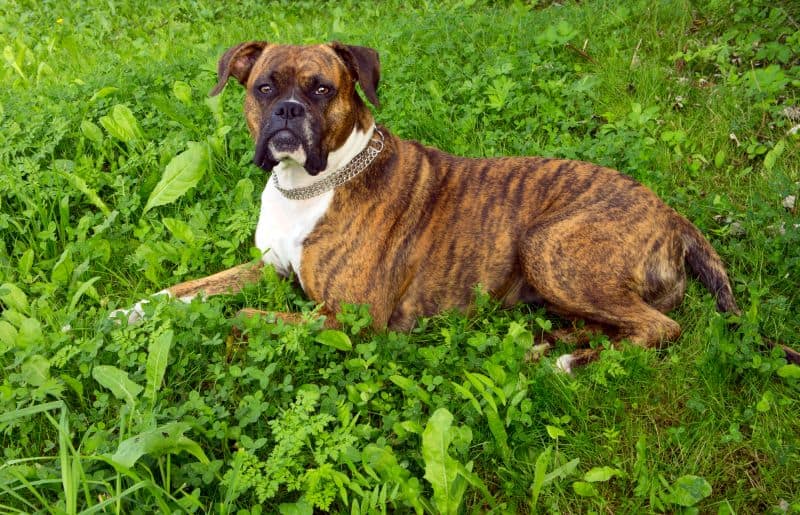
About: The boxer is a medium-sized breed that is well known for his happy-go-lucky nature. His square muzzle and muscular body often cause him to be confused with pit bulls and other bully breeds.
History: Boxers are descendants of an extinct German hunting breed called the Bullenbeisser. The boxer was bred to be used in dog shows, though they’ve proven themselves to be talented herders, police pups, and watchdogs too.
Description: Boxers measure between 21.5 and 25 inches at the withers. They range in weight from 55 to 70 pounds, and their weight should be proportionate to their height without appearing overly bulky. He should always move smoothly, though anyone with a boxer knows they sometimes let their clownish nature shine with a bit of bounce.
Boxers have a large head, but it’s never oversized compared to their body. Wrinkles appear near the ears and muzzle, and he should always appear alert with dark eyes. He has a short, blocky muzzle with a slightly upturned nose, giving him his signature pout.
The boxer’s coat is very short and shiny in appearance. It should be smooth and not overly coarse to the touch.
Colors: Fawn and brindle are the only AKC acceptable colors.
Common Health Issues: Boxers live between 10 to 12 years and may experience a few health concerns, like:
Breed Registries:
The boxer is an all-around excellent family dog. He’s goofy with a playful spirit that meshes well with children, making him a wonderful dog buddy for kiddos. He’s the perfect adventure partner and thrives as a jogging or hiking companion.
He’s happiest when he’s with his family and shouldn’t be left alone while everyone else goes out and has fun. He’d rather be there with you and will make his displeasure known with his propensity to develop separation anxiety.
Boxers are one of the easiest bully breeds to train. He’s easily persuaded with food or positive reinforcement and is intelligent enough to enjoy learning new things regularly. He’s also a friendly guy, though as with any breed, you should socialize him with strangers, new dogs, and small animals from an early age.
The boxer’s grooming needs are minimal. He only needs brushing and bathing when absolutely necessary. Occasional shedding hair needs removal to keep his coat shiny, but other than that and regular nail trims, he’s a breeze.
The boxer is a high-energy breed that requires daily exercise. A long walk and backyard play can meet these needs, but he’s also an excellent fit for canine sports, like agility and herding. Boxers are impressive jumpers, so make sure your yard features a fence that’s at least six feet tall and never leave him in an enclosed area unattended.
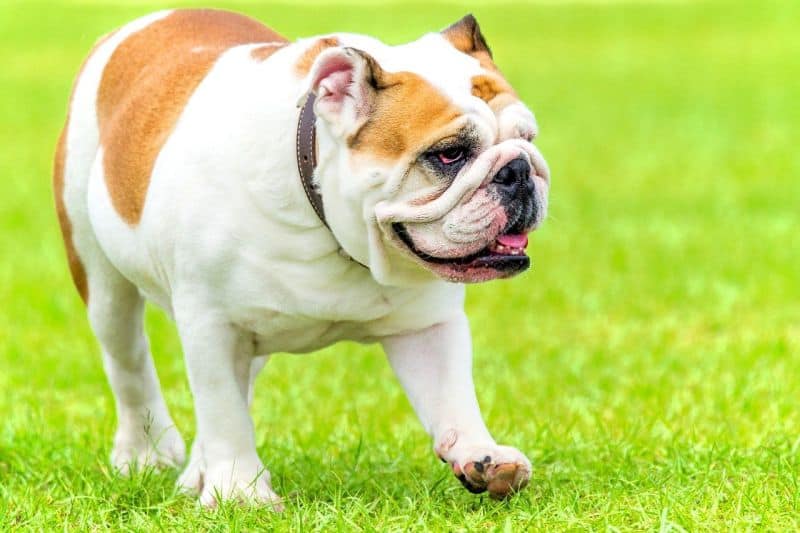
About: A low-riding meatball with a squished snout, the English bulldog is a favorite in the non-sporting group. We know it’s silly, but English bulldogs are sometimes confused with other bully breeds despite being quite different in appearance.
History: Dating back to the 1800s, bulldogs were once much more athletic (and healthy) than they are today. Originally used in bull-baiting, they were powerful dogs with strong jaws, stamina, and a fighting spirit. Over time, they gravitated into the home, and breeding resulted in the shorter muzzle and heavyset shape seen today.
Description: Male bulldogs weigh up to 50 pounds while females top out around 40. Relatively short, they reach 14 to 15 inches at the shoulder. He moves with a signature rolling gait, though always heavily and with confidence. He has wide shoulders and a rounded body that is compact in length, giving him a boulder-like look.
In comparison to their bodies, bulldogs have a large head with low set, dark eyes. All other colors, including blue, are disqualifications of the breed standard. His short, broad muzzle is upturned, leading to his famous pout. His tail is short and stumpy and may be straight or curled in appearance.
Bulldogs have a smooth coat that rests flat against the body. He’s a wrinkly guy from head to toe with thick, loose skin prone to folding, especially around the neck and chest.
Colors: Red, white, fallow, and fawn are acceptable, along with any combination of them. Approved patterns are piebald, brindle, ticking, and masks. Differing colors or patterns, including merle, are prohibited per the AKC standard.
Common Health Issues: Bulldogs aren’t the healthiest breed, with a life expectancy between 8 and 10 years. They are born almost exclusively by cesarean section and are sensitive to anesthesia. Bulldogs are prone to a number of serious health concerns, including:
Breed Registries:
The bulldog makes an excellent family dog. He’s sturdy enough for play but isn’t so bouncy that he’ll send toddlers flying left and right if he’s lived with them from an early age. He gets along with other doggos and pets just fine, but you should encourage him to share toys and food to avoid possessiveness.
Bulldogs are adorable, but they’re also stubborn. He’s a sweet guy that’s easily motivated by positive reinforcement, however, so with early training, he’ll be on track in no time. Sometimes he might do things his own way, but if you keep things upbeat and positive, he’ll waddle back into line.
Your bulldog’s short coat is easy to care for with baths and brushing as needed, but his wrinkles and rolls can get a little yucky. Check and clean his face folds as needed and make sure he’s blotted dry after coming in from the rain. Otherwise, he can suffer from skin irritation or yeast infections.
The English bulldog is a low-energy dog breed, serving as the ultimate couch potato. He’s happy to plop next to you and binge-watch television with a bowl of grub, making him an excellent breed candidate for apartment life.
You need to encourage your bulldog to exercise daily with at least a walk when conditions are suitable or indoor play if it’s too hot. If not, the bulldog is prone to packing on pounds.
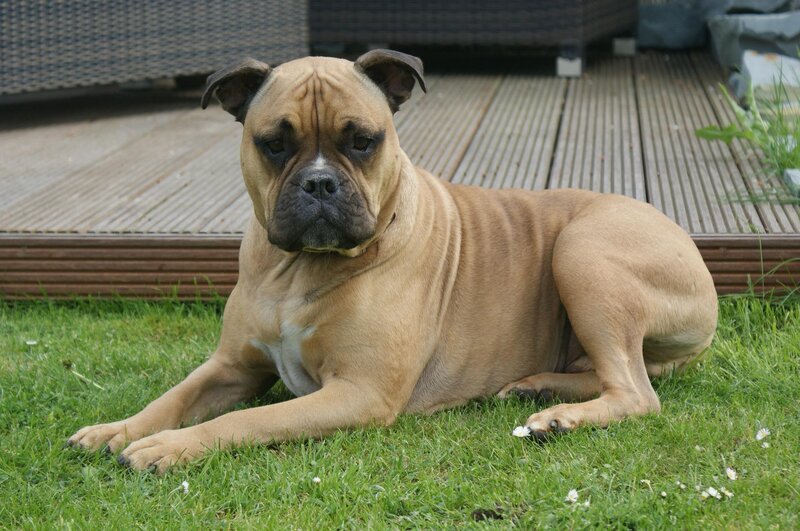
About: The Olde English Bulldogge is a muscular, medium-sized dog with an expressive face. He strongly resembles an English bulldog with a taller, athletic frame, which commonly gets him confused with pitties.
History: The Olde English Bulldogge (OEB) was developed in the 1970s when a group of bulldog fanciers banded together to build back the breed’s original looks, a departure from the English bulldog seen today whose short snout and rotund build greatly impact his health and stamina. Today, the OEB closely matches the appearance of bulldogs from the 1800s.
Description: OEBs are between 16 and 20 inches at the withers. They weigh anywhere from 50 to 80 pounds, making them larger than today’s English bulldog. He moves with a smooth, confident gait. His neck is defined, leading to broad, powerful shoulders and a well-built body that is proportionate. Some have docked tails, but a full, unaltered tail is preferred.
The OEB head should be large but not exaggerated with a squared muzzle. Some wrinkling and hanging jowls are essential, though neither should be excessive. His nose is always black and wide, with his snout length long enough to not impede breathing. OEBs always have brown eyes. All other colors are a fault, per the standard.
The OEB has a short coat that is glossy. His hair is medium in thickness and should never appear long or fringed.
Colors: OEBs come in many shades and patterns, like brindle, white, black, and pied. Disqualifying colors are blue, black and tan, and albinism.
Common Health Issues: OEBs have a life expectancy of 9 to 12 years with health concerns including:
Breed Registries:
The OEB makes an excellent family dog. He’s a sweetheart with his people, though he can be aloof with strangers. He’s agreeable with other animals, including dogs and cats.
As a brachycephalic (short-faced) breed, your OEB should live indoors and never be left for extended periods outside in extreme cold or heat.
As with most bully breeds, your OEB can be stubborn. Early training that is reward-based is best for him. He may be an intimidating tough guy in the looks department, but he’s a big softie on the inside, so never discipline your OEB harshly.
The OEB’s short coat is low maintenance. He sheds a moderate amount, but brushing and bathing as needed will keep his handsomeness intact. Special care should be taken with his facial folds, however, to avoid skin irritation. Clean and/or dry them when necessary.
Your OEB needs regular exercise, though his requirements aren’t as high as other bully breeds. A daily walk will suffice, along with some mental stimulation in the form of backyard play or interactive toys.
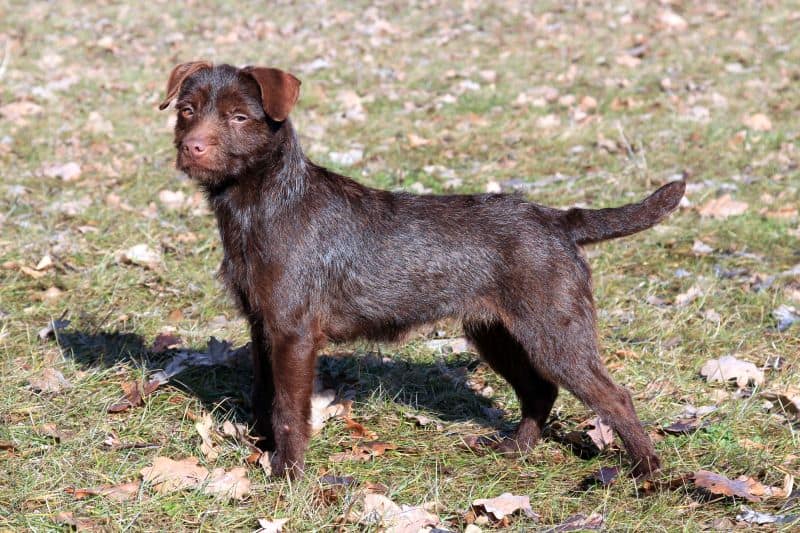
About: The Patterdale terrier is a working breed with more drive than the Energizer Bunny. While he’s the smallest pupper on this list, he might just be the most tenacious. Despite his smaller size, his wide-set eyes and flipped ears are frequently confused with pit bulls and pit bull mixes.
History: Also known as the Black Fell terrier, Patterdales come from northern England. They were bred for killing animals that preyed on sheep, including foxes and badgers. He more than makes up for his lack of size in courage and athleticism, traits that make him a treasured sport dog today.
Description: The Patterdale is a bit of a tiny tornado at a mere 12 inches in height and 13 pounds in weight. Don’t let this fool you, however, as he uses every bit of himself in everything he does. From his neck to his tail, he is well-muscled and built to go toe to toe with whatever he turns up in a burrow.
Patterdales have a large head with a prominent forehead and strong, pointed muzzle. His eyes are positioned far apart and generally dark, though the only discouraged eye color is blue. His ears stand but fold, giving them a floppy, puppylike look.
The Patterdale comes in three coat varieties: smooth, broken, and rough. All are coarse to the touch and waterproof, though the rough coat is long all over, while the broken type features a few longer patches at the muzzle.
Colors: All colors are seen other than white, though a solid pattern is preferred rather than a spotted look.
Common Health Issues: Patterdales live for up to 13 years and are relatively healthy with only a few health concerns, including:
Breed Registries:
The Patterdale loves his owner but isn’t overly affectionate. He should be included in family activities whenever possible, especially to keep this expert digger and troublemaker from making his own fun as he sees fit. He can be a bit much for families with children, but with training and conditioning, he can be an agreeable family dog as long as he’s part of the action.
Your Patterdale is a terrier to the bone, which means he will push you.
He is not a dog for a beginner and will walk all over those who give him the opportunity to do so. He needs structure and obedience training from an early age, along with frequent, ongoing socialization. He’s scrappy and not the best pick for life with other dogs. Due to his high prey drive, he should never be trusted with small animals.
Patterdales need little grooming, regardless of coat type. He sheds little and doesn’t need special stripping like some terriers. He was designed to be low maintenance, making him an excellent hunter’s companion or farmhand.
The Patterdale isn’t a house dog. He needs vigorous daily exercise and a job to do. Jogging and hiking are excellent options for him, as are canine sports like lure coursing, agility, ratting, and more. Most will also enjoy chasing a flirt pole lure in your backyard.
Remember: A tired Patterdale is a happy (and well-behaved) Patterdale.
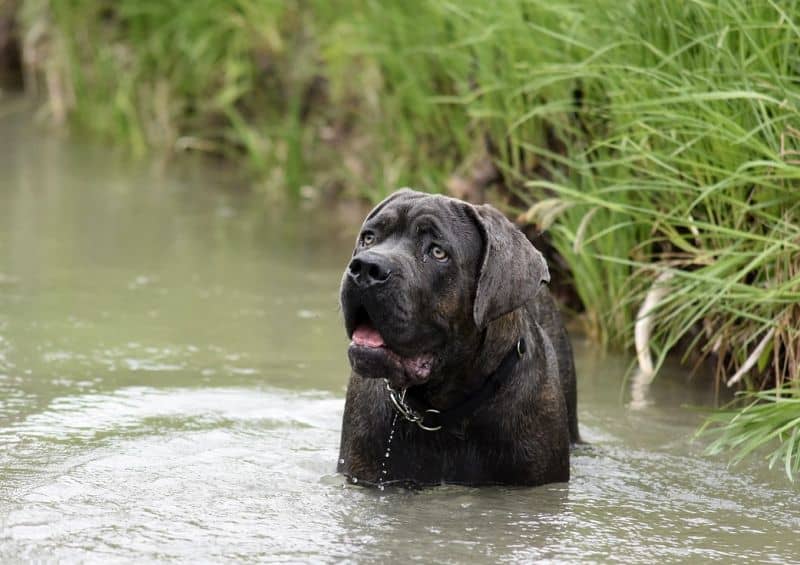
About: The cane corso is a large Italian mastiff that’s prized around the world as a companion and protector. His wide head and bulky muzzle are sometimes confused with other bully breeds, including pit bulls, though he’s far different in appearance and origin.
History: Dating back to ancient Roman times, the cane corso is a working dog who was bred to assist in boar hunting and guarding property. His imposing size and strength suited both jobs, and he’s still used for both today. The breed almost vanished as his popularity waned, though a group of dedicated breeders in the mid to late twentieth century helped them rebound.
Description: The corso is a powerfully built mastiff that stands from 23.5 to 27.5 inches at the withers, depending on sex, and typically weighs between 90 and 120 pounds. His weight should always be proportionate to his height, never affecting his agility or gait. He has a thick neck and broad chest, tapering to a well-muscled frame.
A corso’s head is broad with wrinkles giving him a bit of character between his eyes. The eyes themselves are generally dark, with lighter shades of brown acceptable in gray dogs. Blue and yellow eyes are faults, per AKC standards. His muzzle is wide with noticeable jowls.
His coat should be short and glossy. Despite his coat’s lack of length, he has an undercoat that thickens in cold conditions. To the touch, his hair is stiff.
Colors: Cane corsos come in many colors, including black, blue, fawn, and red. The only AKC color disqualification is tan patterning.
Common Health Issues: Cane corsos live between 10 to 12 years and can experience several health problems, including:
Breed Registries:
Cane corsos may be intimidating in appearance, but they’re gentle giants with their families and quite affectionate. He thrives in the house and isn’t a candidate for outdoor living. He requires ongoing contact with people, and he needs thorough socialization with strangers, dogs, and small animals.
Early training is essential in shaping a well-rounded, obedient dog. Your corso will grow quickly, and getting a handle on his puppy impulses as soon as possible is a must to avoid a bully of a dog who does his own thing. Use firm but positive methods, and you’ll be rewarded with a top-notch doggo who strives to obey commands.
The corso’s short-haired coat sheds, but he doesn’t need much grooming beyond a bath here and there and brushing to remove loose hair. Drooling is a definite concern, especially when he’s drinking, so keep his water bowl on an appropriate surface and a towel handy to wipe away excess drippage.
Your cane corso needs more exercise than other mastiffs. He’s a hard worker and needs daily physical and mental challenges. Long walks and hikes are right up his alley, and if you can get him in a sport like schutzhund or tracking, it’s an excellent way to put his natural abilities to work.
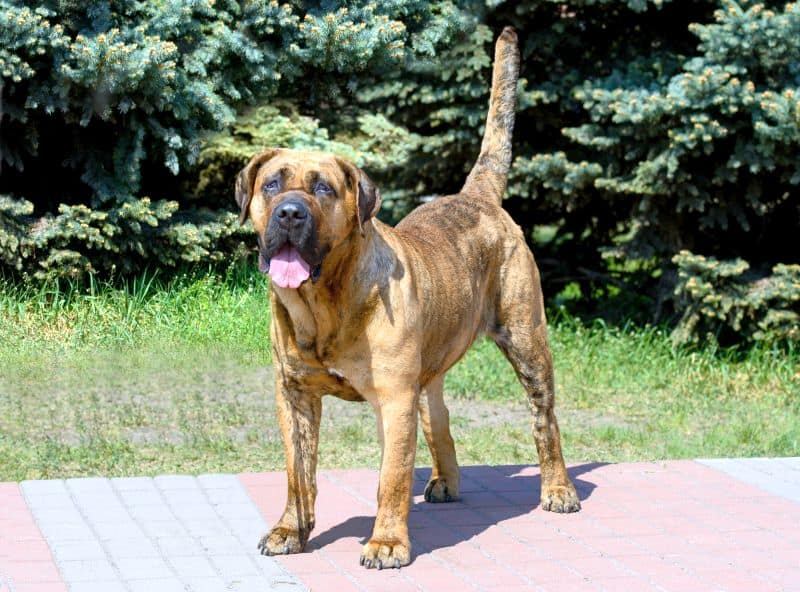
About: Officially known as the Perro de Presa Canario, the Presa is a powerful Spanish mastiff. He is often lumped in with pit bulls, though he’s a remarkably different breed both in appearance and background.
History: Originally from Spain’s Canary Islands, the Presa is a large working breed who got his start with cattle, primarily protecting them from wild dogs and boars. He was also tasked with catching boar or runaway cattle. In addition, they were unfortunately used in dogfighting for a short time, but this wasn’t their original purpose. Today, the Presa remains a prized farm dog, and he’s a favorite catch dog amongst wild hog hunters.
Description: The Presa weighs between 80 and 110 pounds and stands 22 to 26 inches tall. His frame is muscled, especially around the shoulders, tapering back to a defined waist and straight tail with a thick base. He carries himself with the utmost confidence and moves with a long gait.
His head is large with an expressive face and a distinct black mask. The muzzle should be wide with noticeable jowls. Presa eyes range from a medium brown to almost black and should never be light.
The Presa’s coat is short and coarse to the touch. He lacks an undercoat, though, in true mastiff fashion, his skin can be loose, especially around his neck.
Colors: Presas comes in many shades, including fawn and silver, and all variations of brindle patterning.
Common Health Issues: Presas have a life expectancy of 9 to 11 years. They face a few health concerns, including:
Breed Registries:
The Presa is a guardian at heart and loves his family fiercely. He isn’t the same with strangers, however, who he’ll often regard with suspicion. However, through early socialization, he can learn to tolerate their presence.
Since Presas are such large, powerful dogs, training should begin as soon as he comes home, including basic obedience, manners, and introductions to new people and animals to curb his tendency to be standoffish. Sometimes he can be a bit stubborn, but with treats and patience, he’ll stay on task.
Grooming a Presa’s short coat is easy, and he only requires bathing when necessary. He’s an average shedder, and a quick brush is all he needs to remove loose hair. His ears should be monitored for buildup and cleaned accordingly.
While the Presa is a working breed, he doesn’t require a great deal of exercise. He’s laid back indoors, and a daily stroll and backyard play can satisfy his needs just fine. https://www.youtube.com/watch?v=VqUeo5SRMx4